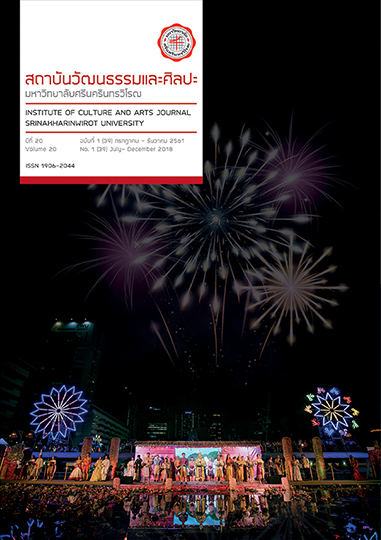USING THE PRINCIPLES OF GROUNDED THEORY FOR GATHERING FOLK WISDOM ABOUT THE TRADITIONAL INTRICATE PAPER CUTTING THECHNIQUES OF THE SOUTHERN THAILAND
คำสำคัญ:
Grounded Theory, Research Methodology, Intricate Paper Cutting Techniquesบทคัดย่อ
The Principles of Grounded Theory is a method that can be utilized as the research objective and methodology for the information gathering of Folk Wisdom, the Traditional Intricate Paper Cutting Techniques (TIPCT) of the Southern Thailand. TIPCT is a traditional folk art & craft in Songkhla Province and Nakhon Si Thammarat Province. This research is centered around information gathering, information categorizing, analyzing the information, summarizing information into key points on TIPCT such as history, objective, paper characteristics, working process, colors, patterns, tools, designing and the process of passing knowledge. That can be managed into the folk art category of Traditional craftsmanship domain in the Thai National Cultural Heritage Inventory. Therefore, the Principles of Grounded Theory were selected because it utilizes the information gathering or societal occurrences categorizing and information connecting. It also leads to a theory for research framework to explain the process, activity, circumstance or interaction of subjects in this research. The samples of TIPCT from southern province, Songkhla Province and Nakhon Si Thammarat Province, were collected from nine artisans. Most of them are male and only one is female, aged 50 years old and above. The works of TIPCT are created from traditional Thai pattern design and use as decoration in traditional ceremonies such as religious ceremony or funeral. Currently it can be found only on the coffin’s decoration of elderly from the Southern provinces.
Downloads
เอกสารอ้างอิง
พรรณี วิรุณานนท์. (2558). โครงการวิจัยงานช่างตอกกระดาษพื้นบ้านภาคใต้: โครงการรวบรวมและจัดเก็บข้อมูลมรดกภูมิปัญญาทางวัฒนธรรมสาขางานช่างฝีมือดั้งเดิม ประเภทงานศิลปกรรมพื้นบ้าน
(จังหวัดสงขลาและจังหวัดนครศรีธรรมราช). กรุงเทพฯ: กรมส่งเสริมวัฒนธรรม กระทรวงวัฒนธรรม.
วิโรจน์ สารรัตนะ. (2556). การวิจัยทฤษฏีฐานราก. สืบค้นเมื่อ 5 พฤศจิกายน 2559, จาก http://phd.mbuisc.ac.th/powerpoint/grounded.pdf
Antony, Bryant; & Kathy, Charmaz. (2007). The SAGE Handbook of Grounded Theory. Los Angeles, Calif: SAGE.
Barney, G. Glaser; & Anselm, L. Strauss. (2010). The Discovery of Grounded Theory: Strategies for Qualitative Research. 5th Ed. New Brunswick, N.J.: Aldine Transaction.
Havanon, Napaporn; Jeradechakul, Pensiri; & Pudthaisong, Surawut. (2007). The Grounded Theory for Strengthened Community. Bangkok: The Thailand Research Fund.
Kathy, Charmaz. (2006). Constructing Grounded Theory: A Practical Guide Through Qualitative Analysis. London: SAGE.
Melanie, Birks; & Jane, Mills. (2011). Grounded Theory: A Practical Guide. Los Angeles, Calif: SAGE.
Sarrattana, Wirot. (2013). Grounded Theory Study. Retrieved November 5, 2016, from http://phd.mbuisc.ac.th/powerpoint/grounded.pdf
Virunanont, Pannee. (2015). The Traditional Intricate Paper Cutting Techniques of the Southern Thailand: The Information Inventorying of Intangible Culture Heritage’s Elements in the Traditional Craftsmanship of Thai Folk Art (Songkhla and Nakhon Si Thammarat). Bangkok: Department of Cultural Promotion, Ministry of Culture.
ดาวน์โหลด
เผยแพร่แล้ว
รูปแบบการอ้างอิง
ฉบับ
ประเภทบทความ
สัญญาอนุญาต
บทความทุกบทความที่ได้รับการตีพิมพ์ถือเป็นลิขสิทธิ์ของวารสารสถาบันวัฒนธรรมและศิลปะ มหาวิทยาลัยศรีนครินทรวิโรฒ



